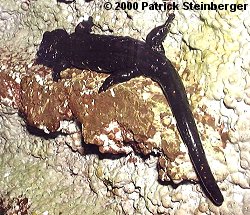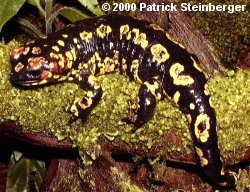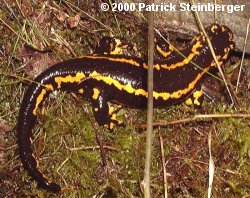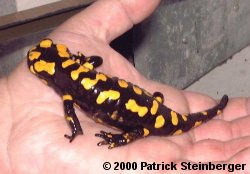| Salamandra | |||||||||||||
| Fire and Alpine Salamanders | |||||||||||||
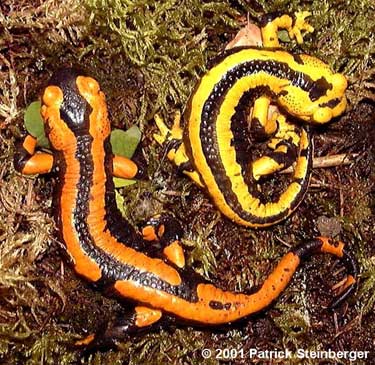 |
| ||||||||||||
| Orange and Yellow variants of Salamandra salamandra terrestris. |
Description
Fire Salamanders are a complex of species and subspecies, many of which have yet to be fully described. The Alpine Salamanders and their subspecies are better defined and, currently, are fewer in number. Current thinking (Steinfartz et al. 2000) indicates the following full species: Salamandra algira (African Fire Salamander), S. salamandra (European Fire Salamanders), S. corsica (Corsican Fire Salamander), S. infraimmaculata (Near Eastern Fire Salamander), S. lanzai (Lanza's Alpine Salamander) and S. atra (Alpine Salamander). For a complete list of Salamandra species and subspecies, see Salamandra Species and Subspecies Guide.
| Species | Common name | IUCN Red Book | First described |
|---|---|---|---|
| Salamandra algira | Algerian Fire Salamander | Vulnerable | Bedriaga, 1883 |
| Salamandra atra | Black Alpine Salamander | Least Concern | Laurenti, 1768 |
| Salamandra corsica | Corsican Fire Salamander | Least Concern | Savi, 1838 |
| Salamandra nfraimmaculata | Near-eastern Fire Salamander | Near Threatened | Martens, 1885 |
| Salamandra lanzai | Lanza's Fire Salamander | Vulnerable | Nascetti, Andreone, Capula & Bullini, 1988 |
| Salamandra salamandra | Fire Salamander | Least Concern | Linnaeus, 1758 |
These salamanders are relatively large, ranging from about 12 cm to 30 cm at adult size (5 to 12 inches). All have prominent parotoid glands, though they are more prominent in some species/subspecies than others. Excepting S. lanzai, all Salamandra species have a double line of poison glands running along the back from between the parotoid glands out on to the tail. There are also two more rows of glands on either side of the body. There is much variation in tail length and shape, though the tail is generally as long or slightly shorter than the body, and cylindrical in shape. Other areas of the body, such as the head, vary in shape between subspecies and species, and one extreme example is the frontal region of the head in S. s. longirostis, which is almost beak-like in shape. The toes are stubby and blunt when compared to the likes of Triturus, and the tail is blunt and rounded at the tip.
The body colouration is usually a glossy black or very dark brown, and the underside is frequently slightly lighter, with occasional flecks of pale colour. Colouration is the most obvious trait that marks the differences between species and subspecies, although body shape is important too. S. algira, S. corsica (Noellert 1992) (pictured below bottom right), S. salamandra and S. infraimmaculata are variants of the typical fire salamander appearance, with varying blotches, spots, flecks and bands of yellow, orange or red over the body, or indeed mixtures of all three colours. Within these four species, the parotoid glands are always coloured (S. s. bernardezi sometimes is an exception), but the degree and type of colouration elsewhere on the body varies greatly, sometimes even within subspecies. It's generally true to say that related animals frequently have common elements to their patterns. The photo at the top of this page shows two variants of S. s. terrestris, the Banded Fire Salamander. The individual on the right is a yellow female, and the other is an example of the much less common orange variant. The bands are typically yellow, extending down the body, but most individuals of this subspecies have more breaks in the bands than the two shown. The variation between species and subspecies is very significant. S. atra (shown below top left) and S. lanzai are typically near-black in colour, with no other colouration. S. s. gallaica (shown below top right) can have a great deal of dark red colouration on the body, frequently within patches of yellow. S. algira often has bright red and yellow patches on the head and yellow elsewhere on the body. S. s. bernardezi (shown below bottom left) is perhaps the most variable subspecies of S. salamandra. Some individuals of this subspecies resemble the banded fire salamander (as is the case in the S. s. bernardezi individual shown below bottom left) and individuals of other forms of S. s. bernardezi have varying degrees of yellow and orange. Some forms of this subspecies even have an overall body colouration of dark brown or dark orange with no other colouration on the body.
In all species and subspecies, the male is generally smaller in build than the female, and has a noticeably more swollen cloaca.
Habits and Life History
Salamandra species display broadly similar behaviour. Activity generally takes place at dusk and during the night. Individuals are occasionally active during the day after rain. Females are sometimes active during the day at breeding time (Kuzmin 2000 and others). Adults have a familiar range, generally about 60 m2 (Denoël 1996), and they usually return to the same refuge after each night's activity (Joly 1968, 1963; Ribéron et al. 2000). Males display a degree of territoriality and sometimes fight during the breeding season. Salamandra are most frequently seen by ordinary people when they have been run over by cars on roads at night. Common refuges are old logs, rodent burrows, deep leaf litter and crevices in rocks and hard ground. Salamandra species are not fossorial like Ambystomatids, but they have been known to dig in moss and forest debris, often when the temperature is high. Activity varies throughout the year, usually ceasing during summer in the south and during the winter in the north, though this can vary within the subspecies and species, due to different temperature tolerances (Degani 1982).
In the south, mating and reproduction usually take place during the cooler months of the year. Central and northern European species mate in late summer or early Autumn, and deposition of larvae follows in the following spring (for example, S. s. terrestris in Germany usually deposit their young between March and June, and in some areas of France, larval deposition can take place in November, before the onset of cold winter weather (Thorn and Raffaëlli 2001)). Salamandra species are lecitotrophically viviparous i.e. larvae hatch from the egg at the moment of birth (Kopp et al. 2000; Greven, 1976). Larvae are usually deposited in moving water (often the calmer parts of small brooks in forests). S. atra, S. lanzai, S. corsica and S. s. bernardezi normally deposit metamorphs, though in the case of S. atra and S. lanzai, usually only two young are born every two or more years in the wild. Even within species/subspecies and even populations of the same subspecies, the stage at which the young are deposited can vary significantly (Denoël 1996). Deposited larvae are typically 2.5 cm in total length (1 inch) and generally metamorphose at between 4 and 6 cm (1.6 - 2.4 inches).
Adults feed on the usual invertebrate fare of worms, insects, arachnids and molluscs. Larvae feed on water crustaceans and other small prey, such as insect larvae (e.g. Emphera). These salamanders are quite long-lived, and captive specimens over 30 years of age are not uncommon.
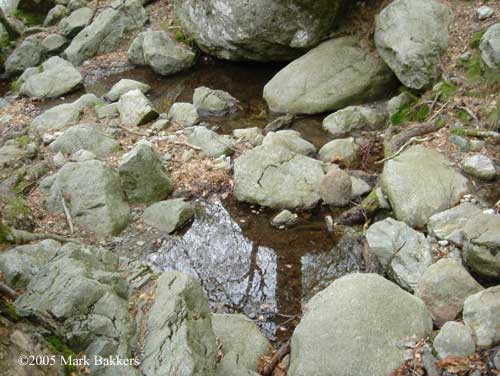
Salamandra breeding pool.
Natural Range and Habitat
The genus Salamandra has a very extensive range. Excluding Scandinavia, the Baltic States, Britain and Ireland, representatives are found in nearly all other European countries as far east as the Black Sea. Salamandra algira is found in Morocco, Algeria and Tunisia. Salamandra infraimmaculata is found in the near East, in countries such as Turkey, Lebanon, and Israel.
Alpine salamanders inhabit alpine forests and woodland at high altitude (sometimes over 2000 metres above sea level). The other Salamandra species prefer lowland forests and woodland, though they also frequent upland regions and upland forested areas. Some inhabit quite arid areas (northwest Africa and the near East).
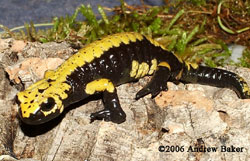
Salamandra atra aurorae. |
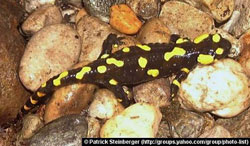
Salamandra salamandra salamandra. |
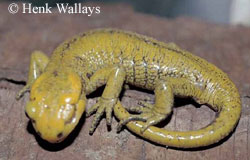
Salamandra salamandra bernardezi, yellow form. | 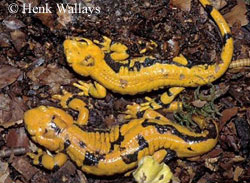
Salamandra salamandra gigliolii. |
Housing and Notes on Captive Maintenance
Given their large nightly range, as with most animals, the larger the vivarium the better. A pair can be housed quite adequately in a 45 cm x 30 cm x 35 cm vivarium (18 x 12 x 14 inches). A 60 cm x 30 cm x 35 cm vivarium would be better, though (24 x 12 x 12 inches). Juveniles can be maintained in a smaller setup until they are nearer to adult size.
If a naturalistic vivarium is desired, the substrate should be leaf litter, mosses and pieces of bark, with a few hiding places such as pieces of cork bark. If breeding is anticipated, a shallow body of water is required for most species/subspecies. These salamanders are very terrestrial, and therefore, a water bowl will not normally be used for any other purpose. These animals will burrow a little, but they don't require a deep substrate, unless you wish to maintain real plants in the vivarium, in which case, a compost and soil substrate is recommended, and this can be topped with leaf litter, moss and bark for the salamanders. It is perhaps better to keep plants in pots to aid ease of cleaning of the vivarium. It is important that the vivarium is kept moist, though not very "wet". This can be accomplished by using a mister every few days or more frequently if the vivarium has no lid.
Some keepers maintain their animals in more simplistic setups that use a substrate of unbleached paper towel that is moistened, and a hiding place is added, such as a piece of bark. This type of setup is easy to clean and probably helps to reduce the likelihood of parasites becoming established in the vivarium. However, whether or not it is ideal for salamanders is debatable. Many breeders use this system, but it is up to the keeper's own discretion. I have found that this system works well, but the addition of pieces of moss, etc, are necessary to break up the bleakness of the paper toweling - otherwise the salamanders tend to try to escape.
One of the most fundamental issues regarding these salamanders is temperature. Most species do well at temperatures at or below 20°C (68°F). Those that live at high altitudes in the wild are more likely to suffer as the temperature rises above this level, though as a rule, all species should be kept at or below this safe ceiling temperature. Some species, such as S. s. infraimmaculata (Degani 1982), S. algira, and many of the more central and southerly Spanish and Portuguese races are probably more tolerant of higher temperatures, but it is a risky business to keep Salamandra above the early 20s°C (early 70s°F). In the wild, the air and surface temperature of many Salamandra habitats rises into the mid-20s°C (< 77°F), but at night the temperature may drop by more than 5°C, and in many cases, more than 10°C. It therefore seems logical that a higher daytime temperature may be somewhat offset by a cooler nighttime period, particularly because this is when Salamandra are most active.
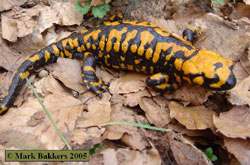
Salamandra corsica. |
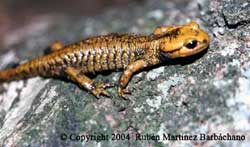
Salamandra salamandra alfredschmidti. |
Feeding
In captivity, Salamandra salamanders are quite willing to take almost any moving prey, be it living or made to move by the keeper. Once used to humans, they can become quite bold and may follow their keeper from within their vivarium. As with all animals, variety is the key. Foods such as earthworms and nightcrawlers (though not the red-ringed ones - genera Eisenia and Dendrobaena) are ideal, but Salamandra will also take crickets, locusts, mealworms (it's a good idea to crush the jaws of mealworms prior to feeding), wax moth larvae (wax worms), white slugs, small snails, spiders and fly larvae. During the active part of the year, adults should generally be fed about twice a week, with perhaps three or four "bite-sized" crickets or equivalent. Supplementing the food with vitamins and minerals is generally not necessary if a varied diet is provided. However, it's always advisable to gut-load crickets prior to feeding. This can be accomplished by feeding them with flaked fish food for a day or two before feeding them to the salamanders.
Newly deposited larvae should be fed on live Daphnia, Cyclops, white worms, blood worms, black worms, etc. They will also take chopped earthworms (again, avoid the red-ringed varieties) and thawed frozen foods, which they detect by smell. Larger larvae will obviously take larger sized foods.
Newly metamorphosed and young juvenile Salamandra do well on fruitflies, gut-loaded hatchling crickets, etc. They are not fussy, but food of an appropriate size should be provided.
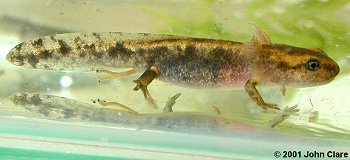 |
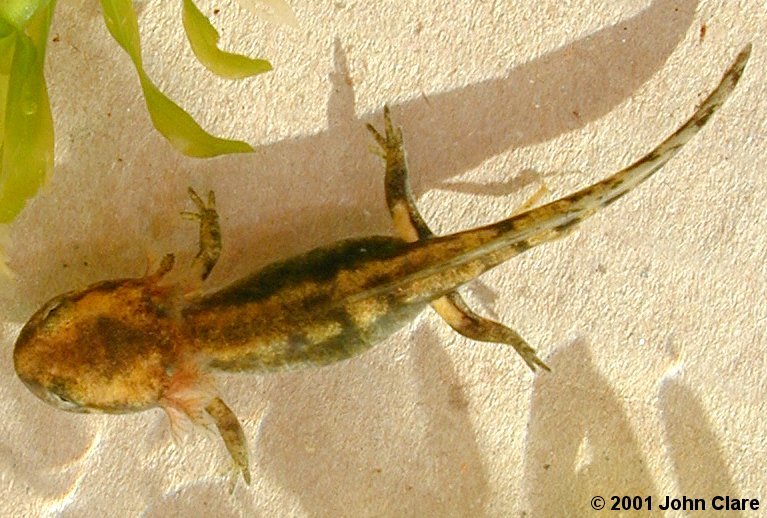 |
Banded Fire Salamander larva, Salamandra s. terrestris, nearing metamorphosis at 5 cm (2 in). | |
Breeding
In captivity, Salamandra salamandra usually mates in early autumn and produces larvae after a cool winter period, from February onwards. This can be modified in captivity by cycling the temperatures to fool the animals into mating and depositing larvae at other times of the year. Mating takes place on land, and the male solicits the female by touching and rubbing the female with his chin. In Alpine Salamanders, this chin rubbing is focused on the female's head. The male crawls beneath the female and grasps her front legs with his own by hooking them over hers. He may further stimulate the female by rubbing his head against her chin. Eventually, the male deposits a sticky spermatophore. He then manoeuvres his hind quarters out from underneath the female's and, in so doing, attempts to lower her cloaca over the spermatophore, which then adheres to her. Sometimes he misses and it can stick elsewhere on female's body. Four-to-nine months after fertilisation, the female deposits young larvae (or metamorphs in the case of some species/subspecies). In the alpine salamanders this procedure is extended, and generally only two metamorphs are produced every two years in some populations. Mating behaviour is similar in all species/subspecies. In species/subspecies that inhabit warmer countries, reproduction can take place entirely during the autumn, winter and spring.
In species that bear larvae, females deposit their young in relatively shallow, usually slowly moving water. The female crawls backwards so that her cloaca and tail are immersed in the water. She then releases 15-70 larvae. Numbers vary between individuals and races, and the number and size of larvae are not necessarily related to the size of the mother (Kopp et al. 2000). When providing water for the female to deposit her larvae into, care should be taken that the water is not deep enough for her to drown in because Salamandra are quite inept in the water.
Larvae typically measure 2.5 cm at birth, though they may be smaller or slightly larger. It's usually a good idea to remove them from the mother's presence as soon as deposition takes place. If fed adequately (see above), they can reach metamorphosis in as little as 4 weeks (Herbert), typically at a total length of 5 cm. Metamorphs are prone to drowning, so be sure that they can leave the water easily. In the case of most larvae, the colouration and patterning of the young fire salamanders becomes evident a few days before metamorphosis. The familiar intense yellows and reds of fire salamanders become more vibrant after metamorphosis, and by the end of the second week the juvenile colouration is fully developed. During these few days after metamorphosis, the shape of the head changes, the parotoid glands develop, the eyes bulge up from the head and the pigmentation of the eyes fades to black. It may take a month before the metamorph shows full adult shape. Metamorphosing animals usually won't eat until a few days after metamorphosis.
In Salamandra salamandra, sexual maturity is usually reached in captivity in the third or fourth year, though some sources report maturity at just 2 years. In captivity, Salamandra atra and Salamandra lanzai can mature in less than 4 years. Accurate sexing can be carried out when the animals are about 12.5-14 cm long.
References
Dave Herbert (2001): Personal communication.
Robert Thorn and Jean Raffaëlli (2001): Les Salamandres de l'Ancien Monde. Societé Nouvelle des Editions Boubée Paris.
Maja Kopp and Bruno Baur (2000): Intra- and inter-litter variation in life-history traits in a population of fire salamanders (Salamandra salamandra terrestris). J. Zool., Lond 250, 231-236.
Sergius L. Kuzmin (2000): Species Account of Salamandra salamandra. Amphibia Web https://amphibiaweb.org/lists/Salamandridae.shtml.
Alexandre Ribéron and Claud Miaud (2000): Home range and shelter use in Salamandra lanzai (Caudata, Salamandridae). Amphibia-Reptilia 21, 255-260.
Sebastian Steinfartz, Michael Veith and Diethard Tautz (2000): Mitochondrial sequence analysis of Salamandra taxa suggests old splits of major lineages and postglacial recolonizations of Central Europe from distinct source populations of Salamandra salamandra. Molecular Ecology, 9, 397-410.
M. Denoël (1996): Phénologie et domaine vital de la salamandre terrestre Salamandra salamandra terrestris (Amphibia, Caudata) dans un bois du pays de Herve (Belgique). Cahiers d'Ethologie 16, 291-306.
Richard A. Griffiths (1996): Newts and Salamanders of Europe. T&AD Poyser Natural History.
A. Noellert and C. Noellert (1992): Die Amphibien Europas. Frackh-Kosmos Verlags-GmbH & co, Stuttgart.
G. Degani (1982): Temperature tolerance in three populations of salamanders, Salamandra salamandra (L.). Brit. J. Herpetol., 6, 186-187.
H. Greven (1976): Noitzen zum Geburtsvorgang beim Feuersalamander, Salamandra salamandra (L.). Salamandra 12, 87-93.
J. Joly (1968): Données écologiques sur la salamandre tâchetée Salamandra salamandra. Ann. Sc. Nat., Zool. 12, 301-366.
J. Joly (1963): La sédentarité et le retour au gite chez la Salamandre tâchetée. C. R. Acad. Sci., Paris 256, 3510-3521.
Written in June 2001 and updated in May 2002. All text and some images © John Clare. Patrick Steinberger's photos are used with permission. All other images are copyright of their respective owners and are used here with permission.

